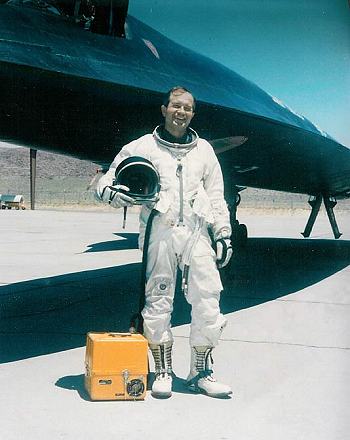
Ken Collins poses with a Lockheed A-12 at Area 51 in the late 1960s. Collins was not wearing a full pressure suit like this when he ejected from his airplane on 24 May 1963 because he was making a low-altitude test flight.
Instantly, the 400-pound canopy blew off. Foot retractors yanked the pilot's boots back against the seat, and a rocket propelled the seat out of the cockpit. Collins felt himself pushed away from the seat and then felt a tug as his drogue chute opened. He took a moment to look at his watch, which read 12:05. At about 15,000 feet, the drogue separated and the main parachute opened, slowing his descent. A few minutes later, Collins released his survival kit to swing freely from its lanyard. Collins' helmet visor fogged up, so he raised it. He saw his tumbling ejection seat and the A-12 still spinning, inverted, toward the desert below. Collins oscillated beneath the chute. When next he saw the airplane it was shattered on the desert floor beneath a column of flame and black smoke a few miles away. Collins prepared himself for touchdown.
He landed on his feet and fell to the left, rolling on his back and shoulder. The wind was blowing, threatening to drag Collins through the scrub. He tried to unlatch the right riser release to collapse the chute, but it wouldn't open. He finally unlatched the left riser, removed his harness, and gathered up the parachute. He also collected checklist pages that had broken loose and various other aircraft items that were lying in the immediate vicinity. Making two trips, Collins moved his gear to another hill in an attempt to get closer to the remains of his airplane. As he started to retrieve the drogue chute, which lay on the ground about 2,000 feet away, he spotted a red pickup truck bouncing across the rugged terrain with its headlights on. The four men in the truck had seen him descending in his parachute and thought he might need help. On the way, they had stopped just long enough to pick up his ejection seat and throw it in the back of the truck.
The four men jumped out of the pickup and, on seeing that Collins was unhurt, put the pilot and his flight gear and drogue chute into the truck. Collins asked the driver, L. A. Hewitt of Salt Lake City, to take him to the nearest Highway Patrol station. Once on the highway, they met Wendover Deputy Sheriff Ed Boyce and transferred all the gear -except the ejection seat - to the officer's station wagon. Collins used Boyce's radio to contact the Highway Patrol and gave them a phone number to call to alert the proper authorities regarding Collins' status. The two vehicles then drove to Weigh Station Number 8 in Wendover where patrolman Roger Skougard coordinated efforts to assist Collins and set up security for the crash site. Two other patrolmen and SSgt. Lloyd D. Gregory, an Air Policeman dispatched from Hill Air Force Base, secured the accident scene.